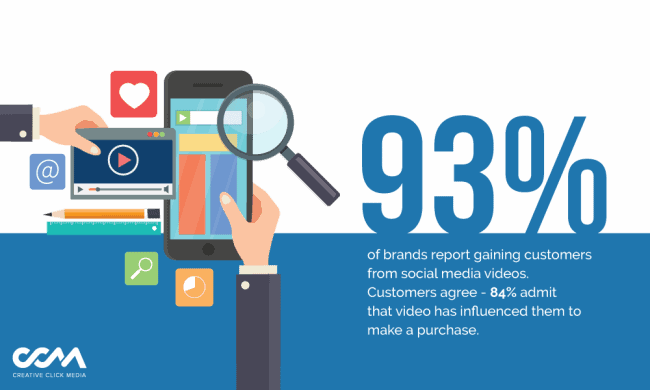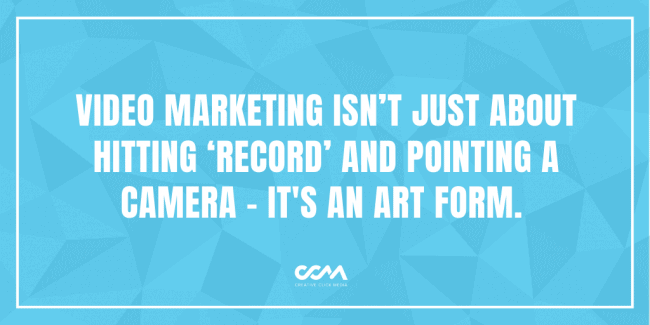Smartphones have come a long way in terms of their photography and video capabilities. Their cameras now have multiple focal lengths, decent sensors, and in-body image stabilization (IBIS), making them neat little tools for taking photos and videos. This leads many businesses to wonder, why can’t I just shoot digital marketing videos on my iPhone? And the answer is, you can, but it is no replacement for more professional cameras. There are certain scenarios where smartphone cameras are more than adequate and others where more professional equipment is essential. It’s important to assess your unique marketing needs to determine what’s right for your business.
When A Smartphone Is Adequate
As much as it pains me to say this as a videographer and film-lover, not every marketing video has to be a big Hollywood production. There are even situations where simplicity is more effective than a highly-produced video.
Statistics from Oberlo have shown that 93% of brands report gaining customers from social media videos. Customers agree – 84% admit that video has influenced them to make a purchase. A well-produced video is always appropriate, but not always necessary. For one, the highest resolution that will play on Instagram is only HD, 1920×1080. While high-end cameras (Like the Sony FX6 or Sony FX9, a cinema camera we use here at Creative Click Media) will still produce a better image than smartphones – in this lower definition, you lose a lot of the detail in the compression. For the layman, this means a high-end camera may be overkill for some social media digital marketing videos.
 Constant Content
Constant Content
Success on social media is more likely with a consistent stream of quality content. Since most businesses need to maintain a reasonable budget, it’s often not feasible to constantly produce high-end video content. This is where smartphone cameras are beneficial. Simple tutorials, announcements and other short content can be quickly filmed with little to no budget and, if done correctly, can receive high levels of engagement. There are entire social media accounts driven solely by the ‘selfie video’ where the influencer speaks directly to the camera in selfie mode, with no editing or production techniques. Smartphone video projects are great for making quick, direct connections with an audience. For a more profound impact, you’ll need to bring in the professionals.
If you want an inexpensive way to double the quality of your smartphone footage, get a ring light or a lighting kit. Ring lights are circular LED lights on a tripod that hold a smartphone in the center of the circle. They can perfectly light a face for a ‘selfie video’ since the circle of light removes all unflattering shadows. If you won’t be primarily filming these types of digital marketing videos, an all-purpose lighting kit is recommended. Note – ‘soft box’ lighting setups are particularly flattering for interviews, as they reduce harsh shadows.
Next-Level Video Marketing
Now that we’ve established smartphone cameras and DIY digital marketing videos can be beneficial, it’s time to acknowledge the harder facts. If you want to portray your brand as a highly-professional authority in its industry, you will need to invest in a higher level of video production. There’s a reason why Hollywood directors aren’t using smartphones. But what exactly do they lack and will anyone notice?
Audio
By far the most important limitation of smartphone videography is its lack of professional audio recording. This may come as a surprise, but viewers are far more likely to forgive low-quality video than low-quality audio. You can have a highly-cinematic video in stunning 4K resolution but, if the audio is bad, viewers often get frustrated and stop watching. The most successful digital marketing videos completely immerse their audience. Nothing will break the immersion like bad audio that sounds like it was recorded inside a tin can. Smartphones have third-party attachments that can improve their audio quality but the quality isn’t even half as good as recording with an XLR microphone found on professional cameras. This is a reason to be wary of videographers who shoot on mirrorless and DSLR cameras as well, which usually only have a lower quality, 3.5mm audio connection. DSLR and mirrorless cameras still produce a great image and make for a great secondary camera but are not ideal for a main professional ‘camera-A.’
Camera Stability & Movement
Clean camera movement is an effective method of keeping an audience intrigued and immersed in a video. Nothing breaks immersion like a shaky handheld video. Larger, over-the-shoulder professional video cameras have a weight and balance to them that allows for smooth, controlled camera movements. The natural camera sway looks more organic than the movement seen with handheld smartphones, DSLRs, and mirrorless cameras.
Shaky video on smartphones, DSLRs, and mirrorless cameras has been reduced with internal stabilization technology (IBIS). However, IBIS technology combats shaky camera movement with a stabilization technique that doesn’t look completely natural. The ergonomics of a smartphone will never offer the same fluid, organic camera movement as a heavy, on the shoulder professional video camera.
There are some rigging options for smartphones that help, but most people don’t have third party videography accessories just laying around the house. Hiring a professional videographer with a proper video camera is a clear solution.
Racking Focus & Depth of Field
One of the most recognizable techniques in cinematography is “racking focus.” This is when the focus of the image switches from one object to another. This is only possible when the camera used has a shallow ‘depth of field.’ Depth of field is the distance between the nearest and the furthest objects that are in focus in an image. A shallow depth of field is when only a narrow distance remains in focus while the rest of the scene is blurred.
The problem with smartphones is two-fold, they don’t have a great depth of field or the ability to rack focus smoothly. The iPhone’s ‘portrait mode’ attempts to create a shallow depth of field but the look is unnatural because there is no smooth rolloff in focus. Professional video cameras have larger sensors and interchangeable lenses that can create a beautiful, shallow depth of field.
As for racking focus, smartphones tend to instantly ‘click’ to the secondary focus position. This immediately takes the viewer out of the immersion, making your marketing message less effective. Professional video cameras allow the operator to slowly or quickly rack focus, depending on the intended effect of the shot.
Experience
Possibly the best answer to why you shouldn’t attempt to shoot your own marketing video on a smartphone is experience. Video marketing isn’t just about hitting ‘record’ and pointing a camera. It’s an art form best left to professionals.
Let’s say an amateur videographer is given all of the best equipment in the world and a professional is given an inexpensive consumer camera. Then, both are told to make a film about the same subject. All of the equipment in the world won’t allow the amateur to make a better finished product than the professional.
So, even if you go out and rent every piece of camera equipment you could ever need, you won’t be much better off if you don’t have the experience. Effective video marketing requires expertise in lighting, directing, cinematography, editing, color correction, and audio engineering. Without the right people producing the video, your marketing budget is best spent elsewhere.
 No Cameras Needed
No Cameras Needed
Often overlooked is the fact that video marketing sometimes requires no cameras at all. Animation software is more accessible and useful than ever. Statistics from Wyzowl show that 83% of businesses surveyed claim the animated explainer videos on their homepage is effective. A whopping 97% of video marketing professionals surveyed say their explainer videos were successful in increasing understanding of their products/services. While many of the animation programs are user-friendly, it does take industry knowledge and experience to create something worth watching. It may be beneficial to use animation software for short, simple social media clips, but a high-quality video requires effective copywriting, timing, art direction and more.

Masters Of The Moving Image
If your video marketing strategy requires more than simple social media clips, it’s essential to go to the experts. Here at Creative Click Media, we have the tools and expertise to create a wide range of digital marketing videos. We operate cinema cameras like the cutting-edge Sony FX9 and mirrorless cameras for secondary angles and gimbal works. With a full lighting set, speciality stabilization rigs, and cinema-quality lenses, we can produce an image that you simply can’t get out of a smartphone.
We understand that not every business has the budget for our full video marketing services. Not to worry, we can also take footage you record and improve it with professional video editing. No matter the project, we are here to bring your vision to life while producing real results. Give us a call at (877) 361-8016 or contact us on our website. We are just a click away.




